September 20th, 2010 · 1 Comment
I used to think that William Wordsworth was kind of a sap, always going on about daisies in a field and all that in his poetry, but since arriving in London, I’ve come to respect his stance a lot more. I still think that Wordsworth is a bit melodramatic, but I understand his need to remember images from nature. I grew up in rural Connecticut, so I’m used to seeing cows, fields, and woods all on my two-minute drive to the center of town. Before this program, I had not spent more than three consecutive days in a city, and I can honestly say that the parks have kept me sane. London is a wonderfully dynamic city, but it’s also exhausting, and I think that the parks here are an absolute necessity for the people who live here.
London, like any major city, is loud, chaotic, fast-paced, and extremely crowded. Walking down Tottenham Court Road is an exercise in agility. Weaving through people all of the time, especially tourists who stop short to take photographs or consult maps, can become extremely frustrating. But inside of the parks, the bustle of the city seems much farther away. In Queen Mary’s Garden at Regent’s Park today, I was almost able to forget that Marylebone Road ran just outside of the gates. It’s quiet, and you can actually hear the sounds of nature. Although some parks undeniably attract more tourists than others, I saw people just laying on the grass sleeping, reading, doing absolutely nothing at all, in all of the parks that I visited. I think that people are just so relieved to be out of the insanity that is London’s streets that they can’t resist the opportunity to sit down and enjoy a quiet moment.
This is reflected in the development of the parks, as well. Regent’s Park and St. James Park were both made into hunting grounds by King Henry VIII, but they’ve become beautiful, public green spaces. Hyde Park and Kensington Gardens really were formed due to necessity; Queen Victoria decided that the public could really use a park to combat the crowded, polluted conditions of a newly industrialized London in the nineteenth century. Wordsworth fell at the beginning of this time–in his day, London was just beginning to become an industrial power, and we can be fairly certain that his description of the city in his poem “Composed Upon Westminster Bridge” were not completely accurate. Wordsworth sought out beauty in nature because he was suffocated by conditions in the city.
Yes, some of the gardens seem a bit contrived (the bridge at St. James Park just happens to offer beautiful, leafy views of both Buckingham Palace and Whitehall), but the English do love gardening. And today in Regent’s Park I saw people ambling slowly through the very well-manicured rose gardens, literally stopping to smell the flowers. Couples were cozied up on benches, people were reading under weeping willow trees, and one gentleman was just conked out in the sun. As I walked down the avenue, I noticed people sunbathing and playing a football match, also a common sight in Hyde Park and Kensington Gardens. No one, regardless of whether or not they were tourists, was in a hurry, and that’s exactly why the parks here in London are so important. People just need an escape from the city for a bit.
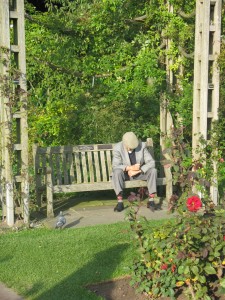
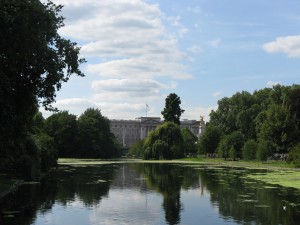
Tags: 2010 Holly
September 20th, 2010 · 2 Comments
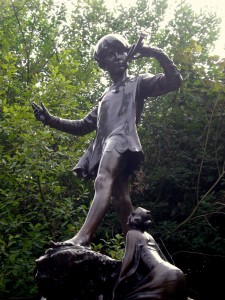
The thing that strikes me most about the parks here in London, aside from the astonishing size and quantity of them, is how kid focused they are. A couple of the girls and I paid a visit to Kensington Gardens last week and discovered this first hand. Before we even entered the park, we could hear the squeals of kids playing on the Diana Memorial Playground. Its design is actually based on the story of Peter Pan. Children can climb aboard Captain Hook’s pirate ship or play in Tiger Lily’s teepee. We wanted to go inside and get some pictures, but the sign on the gate states that if you do not have a child with you, you are not permitted in. I hadn’t ever encountered a child only park, and was honestly a little bit jealous that I couldn’t climb onto the pirate ship.
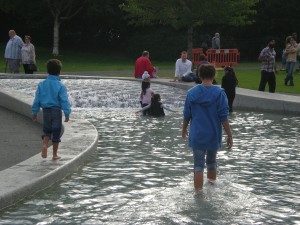
As a New Yorker, I’m partial to Central Park, but even I have to admit that the Brits seem to be beating us in this department. Although Central Park has many things to offer children, it doesn’t have anything that is kids only. I think its really admirable that London’s parks are so devoted to providing kids with a fun and safe environment. The State’s should seriously think about adopting this attitude.

Other locations in the park that seemed geared towards children were the Peter Pan statue, the Round Pond and (spreading into Hyde Park) the Diana, Princess of Wales Memorial Fountain. Although these places were not created specifically for children, it seemed like it was mostly families that were visiting.
Tags: 2010 Sarah
September 19th, 2010 · 1 Comment
I think that one of my favorite things about London is its parks. I have mentioned before in some of my other posts that I don’t think I could ever live in a big city – the crowds and the hurry and the size just stress me out too much. I’ve found that parks are one of the few places where you can have space to walk down a path in a straight line without having to dodge and weave and bump into people and say “sorry.” I’ve found that parks are also a place where you are pretty much guaranteed a place to sit, and you don’t necessarily have to be within ten feet of another person either. It’s lovely that London thought to create places where there is enough space for large amounts of people to be, unlike on the tube or on the streets, where there just simply isn’t. The peace is more beautiful to me than all the trees and flowers and landscaping, although that is pretty too, and a nice break from the architectural chaos of London. I think you really could lose yourself and forget about the city for awhile in parks if you wanted to. When I visited Hyde Park*, I took the following two pictures of the lake:
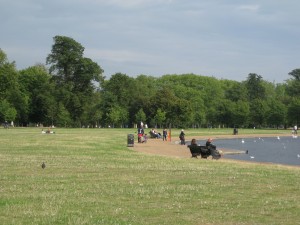
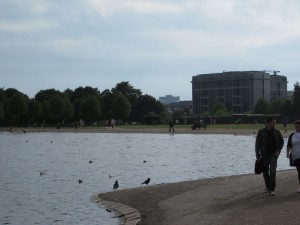
Oh right, the city. There it is. These two pictures seem a bit incongruous; you could probably lie, and tell people that they are different lakes in different places, and they might believe you.
It seems that parks have several different uses for people in London. The first park I visited was St. James Park, and there I joined many other people picnicking on their lunch break. This seems much more enjoyable than inhaling a sandwich on the tube, and if I ever were to work in London, I would want a job where I could eat lunch in the park. The other side of the bridge at St. James however, toward Buckingham Palace, is much more touristy. I was alerted to this by the presence of an ice cream stand, and chairs that you could pay to sit in. I don’t see this as a problem though, as tourists, I am sure, also need a break from the city. Other uses I have seen for parks include
dog walking
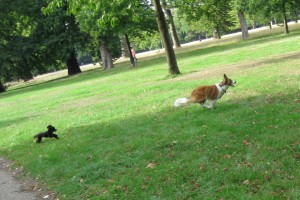
dates

studying

or just being alone and doing whatever you want.

A last really important use for parks, I think, is creating a safe space for children. Professor Qualls brought up this point on the Bloomsbury walking tour, when he took us past the Coram playground, and explained that it was fenced off because you were not allowed in unless you had a child. I saw this again at the Princess Diana Memorial Playground in Hyde Park. It was fenced, plus there was a guard at the door checking people. I witnessed a man come up to the guard and ask if he could see if his wife was in there with his son. The guard told him he could not go in. While this man probably was the father of a child, it is also possible that he could have been a child snatcher, and I personally am a fan of this playground rule that protects children against them. I don’t think we have this in America, or at least I’ve never seen it. At the playground near my house, high school kids smoke pot after school.
While I am excited to move to Norwich and escape the city more or less permanently, when I do return to London, parks will be on my list of places to revisit.
*Note: I am not exactly sure where Kensington Gardens ends and Hyde Park begins. This lake could very well technically be in Kensington Gardens. My apologies to Kensington Gardens if this is the case.
**Note also: all photos in this post are mine. Sorry if you think I’m creepy for taking pictures of random people. It was all in the spirit of academia.
Tags: 2010 Kaitlin
September 19th, 2010 · No Comments
The parks in London, as people have already noted, are places of beauty and enjoyment. Yet, they are not all created equal, well, no, used equally. When relaxing in various ones, I noticed that some were more touristy. In fact, within some, one area was more likely to be touristy that an other.
My first introduction to a London park was when we had class in Russell Square. Clearly, people weren’t used to seeing a group of students (much less Americans) in August discussing various ideas about immigration. Yet, I can’t imagine being at UCL and not using the space for at least small study groups, if not classroom discussions when the weather turns nice.
I adore the idea of small squares littered throughout the city ready for use whenever someone wants an escape from the business and chaos of the city. Of those I noticed, the squares I most wanted to go into were locked and only accessible by the area’s residents. I have mixed feelings on this. On one hand, it’s great for residents to have a safe place to go with their young children or a quiet place where they don’t have to worry about tourists wandering through talking loudly (oops). On the other, why shouldn’t these spaces be opened up for everyone? It feels like one more thing that add to English hypocrisy: they want to pretend when it’s convenient that class doesn’t count, but it seems to exist in these situations when the restricted squares seem to be in areas where income looks to be higher.
For the actual parks, my favorite has been Kensington Gardens. I loved the duality of the park: one side was quiet and peaceful and the other was busy, well, as busy as a park can be. Residents played with their dogs as tourists wandered through taking photos and trying to find the actual park, Hyde Park. Hyde Park was also rather enjoyable, but was far busier on the day I visited. Granted, searching for the Peter Pan statue also lends the visit to being centered around the busier areas. I enjoyed walking through Kensington and observing people and how they interacted with the space (mostly walking their dogs or playing fetch with them, as well as a few taking their young children out for a walk). In Hyde I felt like I was only there to check it off of my list of “Things To Do in London.”
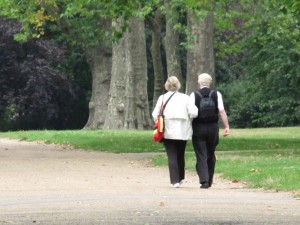
Regent’s Park, while a lot like Hyde in some regard also demonstrated this dualistic atmosphere. The park seemed to have a few tourists wandering through (especially as you got closer to the Zoo and in the more French style areas), but it also had a lot of Londoners, some out walking and others with their family (or dogs). I much preferred the areas that were mostly charming (and alarmingly uneven) paths, where others were walking with their dogs. The other thing that I liked about Regent’s was how family friendly it was. There was a playground that was obviously popular among families with young children.
I’ve enjoyed the parks that I’ve visited and they’ve helped convince me that London is actually my favorite city in the world because of their place in the life of the average Londoner (or student visiting for the month): they’re key to staying sane here. I thrive on the chaos of the city, but sometimes nothing is better than a quiet stroll through a park or an hour reading in a square. I hope that as I venture to other places in England that I will be able to go to a few other cities’ gardens/squares/parks and see how they differ.
Tags: 2010 Stephenie
September 9th, 2009 · 3 Comments
So, last night we went to the Royal Albert Hall for an orchestral concert. I really liked the first and the last piece, and although i only took a short nap during the second piece, I spent most of the evening thinking about the architecture. I kind of felt like we were sitting at the bottom of a pond, looking up a lilly pads and gazing out onto a greenly- illuminated organ. There was even a frog. I had done some background research on good old Prince Albert before because of my trip to Kensington Gardens. But I realized that most people probably don’t know much about Prince Albert or what he did for British society. Other than being the name-sake of some painful looking rings, he doesn’t really come into conversation much on the day to day basis. Prince Albert was a consort, which meant he had no actual power or duties, but I guess that’s what you get when you marry your first cousin. Anyway, because of this he had to look elsewhere to make a name for himself. Thus he looked to make social changes. He dipped his hands in the abolition of slavery in the colonies, child labor laws and social welfare. As I mentioned in a previous post, he was a great supporter of the arts; the monument dedicated to him expresses that quite efficiently. He was also one of the first people to introduce new areas of study into Cambridge.
So why is it that he goes so unsung other than through the efforts of his wife’s broken heart? He halted potential war with the United States, for Pete’s sake! I would wager it is his status, and the classist infrastructure of English society. In his own words “but the difficulty in filling my place with the proper dignity is that I am only the husband, not the master in the house.” (courtesy of wikipedia and Albert to William von Lowenstein, May 1840, quoted in Hobhouse, p. 26). To everyone else, he was just the husband and so all these actions he did were, I think of selfish endeavors rather than actual attempts to better the world. Surely it all ended well and good, but i wonder if he had been King, would he have still gone through with his crusade for the poor and downtrodden, or the artistically inclined? Maybe it would have gone the same way. After all Queen Victoria opened up the parks for the factory workers and worked to create a stronger constitutional monarchy.
Also as a note: the Prince Albert piercing has not connection historically to our good fellow, except in sharing a name.
Used this source and the one noted above: http://www.bbc.co.uk/history/historic_figures/albert_prince.shtml
Anyway, cheers
Tags: Andrew R












